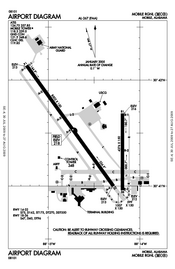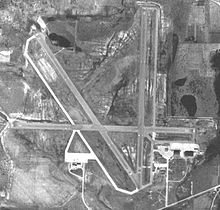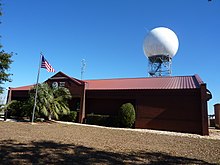

Mobile Regional Airport Coast Guard Aviation Training Center Mobile
(former Bates Army Airfield)
| |||||||||||||||
|---|---|---|---|---|---|---|---|---|---|---|---|---|---|---|---|
 | |||||||||||||||

USGS 2006 orthophoto
| |||||||||||||||
| |||||||||||||||
| Summary | |||||||||||||||
| Airport type | Public / military | ||||||||||||||
| Owner/Operator | Mobile Airport Authority | ||||||||||||||
| Serves | Mobile, Alabama | ||||||||||||||
| Location | Mobile County | ||||||||||||||
| Elevation AMSL | 219 ft / 67 m | ||||||||||||||
| Coordinates | 30°41′29″N 88°14′34″W / 30.69139°N 88.24278°W / 30.69139; -88.24278 | ||||||||||||||
| Website | www.mobairport.com | ||||||||||||||
| Maps | |||||||||||||||
 FAA airport diagram | |||||||||||||||
 | |||||||||||||||
| Runways | |||||||||||||||
| |||||||||||||||
| Helipads | |||||||||||||||
| |||||||||||||||
| Statistics (2018) | |||||||||||||||
| |||||||||||||||
Source: Bureau of Transportation Statistics,[1] Federal Aviation Administration[2] | |||||||||||||||

Mobile Regional Airport (IATA: MOB, ICAO: KMOB, FAA LID: MOB) is a public/military airport 13 miles (21 km) west of Mobile, in Mobile County, Alabama, United States.[2] The airport is owned and operated by the Mobile Airport Authority,[2] a self-funded entity that receives no local tax dollars.
The National Plan of Integrated Airport Systems for 2011–2015 categorized it as a primary commercial service airport.[3] Federal Aviation Administration records show the airport had 286,956 passenger boardings (enplanements) in calendar year 2008,[4] 280,491 in 2009 and 277,232 in 2010.[5]
The airport is home to U.S. Coast Guard Aviation Training Center, Mobile, providing advanced training to U.S. Coast Guard pilots and aircrew in MH-65D Dolphin and MH-60T Jayhawk helicopters, as well as the HC-144A/B Ocean Sentry turboprop aircraft. The Alabama Army National Guard's 1st Battalion, 131st Aviation Regiment's "B" Company is also located at the airport.
In August 2020 it was announced that the Mobile Airport Authority will shift commercial airline flights to the more convenient Mobile Downtown Airport, now renamed Mobile International Airport.[6]
Eastern Air Lines served Mobile from the 1930s until 1991; in the 1930s Eastern's one flight a day each way between Newark and San Antonio stopped at what is now Mobile International Airport.
During World War II, the United States Army Air Forces used Mobile Regional Airport. The 533d Army Air Force Base Unit commanded the airport, then known as Bates Field. The Army Air Forces also operated an auxiliary airfield at St. Elmo Airport.
The Army used this airport as a basic (level 1) pilot training airfield, under contract to Waterman Airlines. They performed flying training with Fairchild PT-19 aircraft as the primary trainer. The Army also assigned several Boeing-Stearman Model 75 aircraft. The Army also used Bates for glider pilot training under contract to Mobile Area Soaring, which used primarily Douglas C-47 Skytrain and Waco CG-4 unpowered gliders. The school aimed to train student pilots in proficiency in operation of gliders in various types of towed and soaring flight, both day and night, and in servicing of gliders in the field.
In 1944 with the reduced demand for pilots, the Army ended the flying training, and Domestic Transport Division of Air Transport Command used the airport as a transport airfield. Air Transport Command moved operations to Brookley Army Airfield (later Brookley Air Force Base) near downtown Mobile in late 1945.
The U.S. Air Force returned to Bates Field in May 1959 when the Air Force Reserve activated the 78th Troop Carrier Squadron at the airport with Fairchild C-119 Flying Boxcar aircraft. In 1961, the Air Force moved this squadron to Barksdale Air Force Base in Louisiana as a Douglas C-124 Globemaster II heavy-lift squadron. The 357th Troop Carrier Squadron then replaced it and acquired the C-119s. The Air Force subsequently upgraded Bates to a Group level upon organizing the 908th Troop Carrier Group, Medium in 1963. However, the Air Force then moved the reservists to the larger Brookley Air Force Base located near downtown Mobile in October 1964 due to budget restraints.
In 1966 the U.S. Coast Guard acquired the vacant U.S. Air Force Reserve facility on the airfield. On December 17, 1966, the Coast Guard officially commissioned an Air Station in Mobile with Grumman HU-16 Albatross fixed wing aircraft from the Coast Guard's Air Station in nearby Biloxi. The Coast Guard also established a fixed wing and helicopter training facility at the airport. U.S. Coast Guard Air Station Mobile serves as an Aviation Training Center with a designated headquarters unit that is under the direct control of the Commandant of the Coast Guard.
Eastern Airlines was first at Mobile, at the airport south of town until about 1941 when it and National moved to the present airport. In the 1960s Eastern Airlines flew Lockheed L-188 Electras to Mobile, then Boeing 727-100s and Douglas DC-9s mainly to Atlanta. Eastern served Mobile until its demise in 1991.
National Airlines Jacksonville-New Orleans flights stopped at the airport south of Mobile starting about 1939. National Lockheed L-188 Electras appeared in 1962–63; later their Boeing 727-200s flew nonstop to New Orleans and Houston. After its acquisition of National, Pan Am 727s served the airport until 1981.[7]
Capital Airlines began Mobile flights in 1948; United Airlines acquired Capital in 1961 and served Mobile with Douglas DC-6Bs and Capital's Vickers Viscounts. Mobile's first jets were United Sud Aviation Caravelles to Newark via Birmingham in April 1962. United ended mainline service to Mobile in 1971, but United Express regional jets still serve the airport.
Southern Airways arrived at Mobile in 1950–51; in the 1970s Southern flew nonstop Douglas DC-9s to Atlanta and New Orleans. Southern merged with North Central Airlines to form Republic Airlines which was acquired by Northwest Airlines which continued at Mobile with DC-9s to the Northwest hub in Memphis. Northwest eventually merged into Delta Air Lines.
Starting in 1981 American Airlines Boeing 727-200s flew to Dallas/Fort Worth Airport via Jackson, MS or New Orleans, LA.[8] American also flew to its hub in Nashville from the mid-1980s to the early 1990s before the airline closed that hub.
USAir (later US Airways and now merged into American Airlines) flew nonstop to Charlotte, NC in the mid 1990s with McDonnell Douglas DC-9-30s and Fokker 100s.[9]
Texas International arrived in 1979; successor Continental Airlines flew Boeing 737-200s and McDonnell Douglas DC-9-30s nonstop to Houston Intercontinental Airport in the late 1990s. Continental has since merged into United Airlines.[10]
The MC Farmer Terminal was completed in 1985.[11]
United Airlines via United Express served Mobile from its hubs in Chicago (ORD) and Washington D.C. (IAD). After the September 11, 2001 attacks, United canceled all service at Mobile. United Express reinstated nonstop service to Houston (IAH) and Chicago (ORD) after the merger of United with Continental Airlines. On September 5, 2018, United stopped flights to Chicago (ORD), citing low demand. All United Express flights at Mobile are regional jets.
In 2006 Delta Air Lines dropped several flights from Mobile and Continental Airlines added flights. In December 2006 Delta had six weekday flights to Atlanta and one to its Cincinnati hub. Delta ended service to Cincinnati on December 12, 2006.
American Airlines restored flights to Chicago (ORD) in April 2007 but ended them in September 2008. Flights to Charlotte and Dallas/Ft. Worth continue on its American Eagle affiliate with Embraer ERJs.
In 2010 Northwest Airlines merged into Delta Air Lines. Northwest had operated nonstops from Mobile to its hub in Memphis; those flights ended after the merger.
After its merger with Continental Airlines in 2012 United Airlines (via its United Express regional affiliate operated by ExpressJet) resumed flights to its hub in Houston (IAH), seven weekday flights. United Express resumed service to the hub in Chicago (ORD) on April 9, 2013.
It was at the Mobile Regional Airport that President George W. Bush, in the immediate aftermath of Hurricane Katrina on September 2, 2005, praised Michael D. Brown, director of the Federal Emergency Management Agency (FEMA). Bush lauded Brown with the phrase "Brownie, you're doing a heck of a job"[12] in front of Brown, the media, and assembled politicians and cabinet officials (including Mississippi Senator Trent Lott; Mississippi Senator Thad Cochran; Mississippi Governor Haley Barbour; Alabama Governor Bob Riley; Michael Chertoff, Secretary of the Department of Homeland Security, and Alphonso Jackson, Secretary of the Department of Housing and Urban Development). Only ten days later, on September 12, 2005, Brown announced his resignation after intense criticism of FEMA's perceived shortcomings in its response to Katrina. The phrase "heck of a job" then became synonymous with an utter mess.

Mobile Regional Airport covers 1,717 acres (695 ha) at an elevation of 219 feet (67 m). It has two runways: 15/33 is 8,502 by 150 feet (2,591 x 46 m) and 18/36 is 4,376 by 150 feet (1,334 x 46 m). It has one asphalt helipad, which is 100 by 100 feet (30 x 30 m).[2][13] The National Weather Service Forecast Office for Southern Alabama, situated near Airport Road and the runway, has a full complement of meteorological instruments, including à NEXRAD weather radar. The airport has 6 gates with jetways.
The terminal at Mobile Regional Airport has renovated shops and restaurants, such as local favorite Carpe Diem Coffee and Tea, car rental agencies, and handicap accessible elevators.
In the year ending October 30, 2021 the airport had 75,034 aircraft operations, average 205 per day: 72% military, 14% general aviation, 8% air taxi, and 5% airline. 31 aircraft were then based at this airport: 6 single-engine and 25 military.[2]
The major carriers out of Mobile are United Airlines and Delta Air Lines, based on the number of flights. Additional weekday departures were as follows: Charlotte (four flights via American Eagle) and Dallas/Fort Worth (three flights via American Eagle). Schedules were slightly reduced on the weekends.
Various carriers represent all three major airline alliances—SkyTeam, Star Alliance, and Oneworld—at Mobile, allowing for connections to partner airlines.
Regional airlines flying for the major network airlines, as listed, primarily serve Mobile. Delta Air Lines alone operates mainline passenger service from the airport and uses such jet types as the Boeing 717 and the Airbus A319. Delta also operated the McDonnell Douglas DC-9-50 into Mobile prior to the retirement of this aircraft type from their fleet. All other scheduled passenger services are currently operated with either CanadairorEmbraer regional jet aircraft.
The following are flown nonstop or direct from Mobile:
| Airlines | Destinations |
|---|---|
| American Eagle | Charlotte, Dallas/Fort Worth |
| Delta Air Lines | Atlanta |
| Delta Connection | Atlanta |
| United Express | Houston–Intercontinental, Washington–Dulles[14] |
| Destinations map |
|---|
|
Red = Year-round destination Blue = Future destination |
| Rank | Airport | Passengers | Carriers |
|---|---|---|---|
| 1 | 117,020 | Delta | |
| 2 | 58,790 | American | |
| 3 | 51,030 | United | |
| 4 | 48,080 | American |
| Rank | Airline | Passenger | Market Share |
|---|---|---|---|
| 1 | Endeavor | 105,000 | 20.19% |
| 2 | SkyWest | 96,010 | 18.49% |
| 3 | Delta | 91,780 | 17.67% |
| 4 | Piedmont | 63,230 | 12.17% |
| 5 | PSA | 51,890 | 9.99% |
| Other | 112,000 | 21.48% |
The airport has a reputation for high domestic fares, usually attributed to the lack of a true low-cost carrier (LCC) serving the airport, such as JetBlueorSouthwest Airlines.[citation needed] Low-cost carrier AirTran Airways served the airport for a time, but Delta Air Lines and other airlines matched fares on the routes that AirTran served, and passengers continued to fly the traditional network carriers. AirTran ultimately discontinued all service, and fares increased once again. AirTran later entered the Pensacola market, and fares dropped significantly from Pensacola International Airport. Because of this, many people drove about an hour in either direction to Pensacola International AirportinFlorida or the Gulfport AirportinMississippi. Fares from Pensacola were lower primarily on routes that AirTran served, while on other routes, including international services, Mobile and Pensacola offered similar fares. AirTran, however, was acquired by Southwest beginning in 2011 and ending in 2014.
In order to attract and maintain frequent flyers, Mobile Regional Airport offered the first airport-based frequent flyer program, called Passport. Passport was launched with a media blitz and new slogan: "Fly Smarter, Fly Mobile."
The Mobile Airport Authority encourages passengers to use multiple airlines to stimulate more competition and lower fares, and it continues to work to attract a low-cost carrier. The Authority also believes that both Mobile and Pensacola would be better served if a single airport was built to serve both cities in Baldwin County—midway between both cities. However, the Authority claims that Pensacola officials do not want their airport in Alabama and have withdrawn from exploratory discussions.[16]
|
| |||||
|---|---|---|---|---|---|
| History |
| ||||
| Geography |
| ||||
| Politics |
| ||||
| Economy |
| ||||
| Culture |
| ||||
| Architecture |
| ||||
| Historic sites |
| ||||
| Green spaces |
| ||||
| Education |
| ||||
| Museums |
| ||||
| Media |
| ||||
| |||||